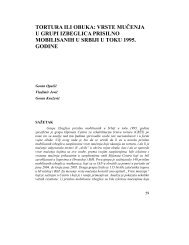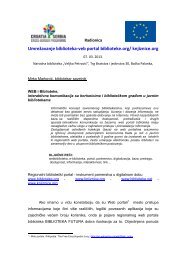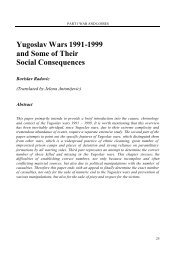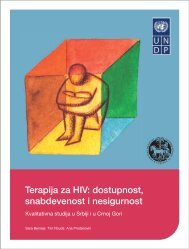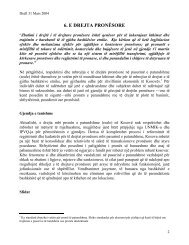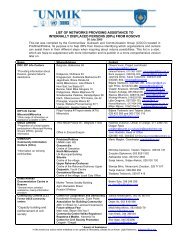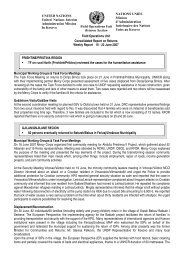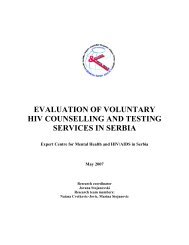Psychological Preparation of Torture Victims as Witnesses toward ...
Psychological Preparation of Torture Victims as Witnesses toward ...
Psychological Preparation of Torture Victims as Witnesses toward ...
Create successful ePaper yourself
Turn your PDF publications into a flip-book with our unique Google optimized e-Paper software.
PART VII LEGAL AND PSYCHIATRIC ASPECTS<br />
Concurrently, a therapist must be aware <strong>of</strong> the needs <strong>of</strong> the victim, which directs<br />
and determines the further approach. These needs entail the respect <strong>of</strong> their (victims’)<br />
boundaries, the need to feel acknowledged, not <strong>as</strong>sessed, to talk and be listened to, to pay<br />
attention to their feelings and to recognise their individual time lines <strong>of</strong> recovery.<br />
Therefore, the therapist’s approach should allow presence, care, listening and empathy,<br />
with the optimum me<strong>as</strong>ure <strong>of</strong> neutrality retained. Special care should be taken that the<br />
setting provides an intimate and comfortable atmosphere and that all objects are visible (the<br />
absence <strong>of</strong> screen) always bearing in mind that tension may provoke the presence <strong>of</strong> things<br />
which we pay no attention to. Any possibility <strong>of</strong> surprise should be carefully eliminated to<br />
ensure the patient’s sense <strong>of</strong> control.<br />
The objectives <strong>of</strong> psychological preparation are: the diagnostics <strong>of</strong> current<br />
psychiatric disorders and their healing <strong>as</strong> well <strong>as</strong> the reduction <strong>of</strong> anticipatory anxiety<br />
related to the litigation process. It is necessary to establish a diagnosis in order to determine<br />
a strategy <strong>of</strong> further therapeutic treatment <strong>as</strong> well <strong>as</strong> predict possible reactions throughout<br />
the court process. Diagnostic documents may also have forensic significance in the event <strong>of</strong><br />
forensic expertise or compensation proceedings.<br />
Components <strong>of</strong> CISD (Critical Incidence Stress Debriefing; Busuttil et al., 1995),<br />
crisis interventions, cognitive behavioural methods which also encomp<strong>as</strong>s EMDR (Eye<br />
Movement Desensitisation and Reprocessing) are used for therapeutic purposes, but brief<br />
focused analytically oriented methods and supportive psychotherapy are also applied. The<br />
reduction <strong>of</strong> anxiety is achieved by means <strong>of</strong> relaxation techniques. Frequently it is<br />
necessary to administer psychotropic drugs in the course <strong>of</strong> a certain period prior to and<br />
immediately before the court trial. Besides anxiolytics and hypnotics, beta blockers may<br />
also be administered while the administration <strong>of</strong> antidepressants should be introduced at<br />
le<strong>as</strong>t a month prior to the court process.<br />
In many courts throughout the world there are services providing support to<br />
victims whose staff also include psychologists and social workers. Such a pr<strong>of</strong>ile <strong>of</strong> experts<br />
is especially required in courts where war crimes are processed (e.g. the International<br />
Criminal Tribunal for the Former Yugoslavia in The Hague) and their role is clear in the<br />
period prior to, during and after the testimony. Prior to the testimony the victim is<br />
confronted with an unpredictable period <strong>of</strong> waiting, closed or isolated environment,<br />
expectation <strong>of</strong> the unknown, cultural and language barriers, and so forth. The psychological<br />
preparation in this ph<strong>as</strong>e is aimed at helping the person to relax, which is achieved by<br />
constant informing, paying attention to practical needs and relief from anxiety.<br />
During the court proceedings, which represents the mo st stress-inducing part, the<br />
best prevention <strong>of</strong> retraumatisation is achieved by means <strong>of</strong> technical me<strong>as</strong>ures for the<br />
witness protection such <strong>as</strong>: testimony delivery in writing or behind the screen or via direct<br />
television transmission, by which the direct confrontation with the accused is avoided<br />
unless the witness himself/herself insists on the direct confrontation. The psychological<br />
support throughout the litigation is limited to the provision <strong>of</strong> surroundings which allows<br />
rele<strong>as</strong>e, rest and self-possession. Here attention should be also paid to the practical needs,<br />
383




